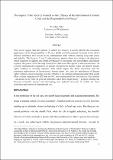The impact of the Security Council on the efficacy of the International Criminal Court and the responsibility to protect
Abstract
This article argues that the manner in which the Security Council inhibits the consistent application of the Responsibility to Protect (R2P) and International Criminal Court (ICC) referrals reinforces their power in the international order without creating long term peace and stability. The Security Council’s discretionary powers allow it to subjectively determine which situations to address and which lawbreakers to prosecute; this consolidates, and indeed expands, the power of the Security Council in relation to other agents of international law. As a result, international cooperation to protect and promote human rights and punish human rights violators is currently impeded. This article argues that those concerned with the consistent enforcement of international human rights law, and the punishment of human rights violators, must accept the need for reforms to the current international order that would allow a better integration of R2P and the ICC into international law and practice. Our reforms – advanced in the form of general principles taken from legal theory – propose altering the Security Council’s powers and developing new judicial structures to enable the more consistent application of international law
Citation
Hehir , A & Lang , A 2015 , ' The impact of the Security Council on the efficacy of the International Criminal Court and the responsibility to protect ' , Criminal Law Forum , vol. 26 , no. 1 , pp. 153-179 . https://doi.org/10.1007/s10609-015-9245-4
Publication
Criminal Law Forum
Status
Peer reviewed
ISSN
1046-8374Type
Journal article
Rights
Copyright © Springer Science+Business Media Dordrecht 2015. This work has been made available online in accordance with publisher policies or with permission. Permission for further reuse of this content should be sought from the publisher or the rights holder. This is the author created accepted manuscript following peer review and may differ slightly from the final published version. The final published version of this work is available at https://doi.org/10.1007/s10609-015-9245-4
Collections
Items in the St Andrews Research Repository are protected by copyright, with all rights reserved, unless otherwise indicated.

